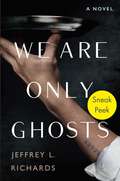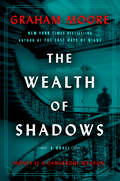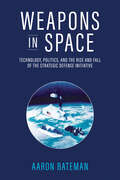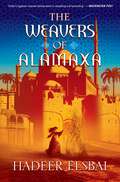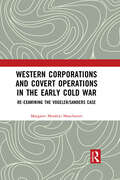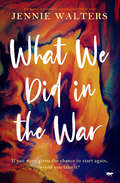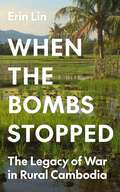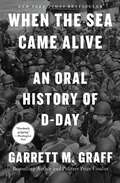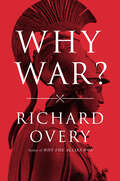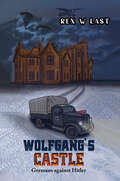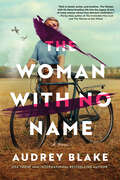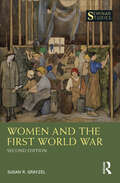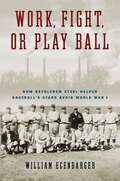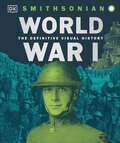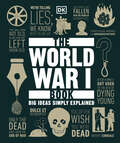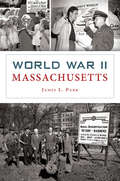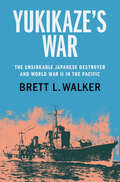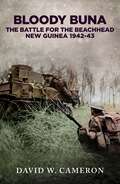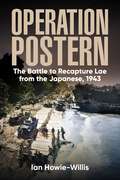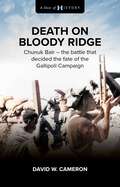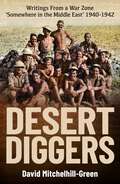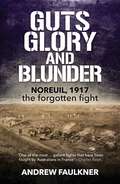- Table View
- List View
We Are Only Ghosts: Sneak Peek
by Jeffrey L. RichardsBe one of the first to read this sneak preview sample edition before the full length novel comes out!An extraordinary, emotionally intense novel spanning World War II Europe to 1960s New York City with an unsettling psychological edge, We Are Only Ghosts depicts not only the horrors of the death camps but the toll on those who survived—powered by a story of the unexpected, complicated connection between a Nazi officer and a young Jewish boy. New York City, 1968: The customers at Café Marie don&’t come just for the excellent coffee and pastries. They come for the sophisticated ambiance, and the illusion of being somewhere other than a bustling, exhausting city. Headwaiter Charles Ward helps create that illusion through impeccable service—unobtrusive, nearly invisible, yet always watchful. It&’s a skill Charles honed as a young Jewish boy in war-torn Europe, when avoiding attention might mean the difference between life and death. But even then, one man saw him all too clearly—a Nazi officer who was both his savior and tormentor. At seventeen, Charles was deported to Auschwitz with his family. There he was singled out by Obersturmführer Berthold Werden, who hid him in his home. Their entanglement produced a tortured affection mixed with hatred that flares to life again, decades later, when Berthold walks into Café Marie. Drawn back into Berthold&’s orbit, Charles is forced to revisit the pain and the brief, undeniable pleasures of the life he once knew. And if he acts on his growing hunger for revenge, will he lose his only tether to the past—the only other witness to who he was and everything he endured—or find peace at last?
The Wealth of Shadows: A Novel
by Graham Moore&“A thriller of a different kind—with an unlikely band of economists and bureaucrats working in the shadows to save the world.&”—Charles Frazier, New York Times bestselling author of Cold MountainAn ordinary man joins a secret mission to bring down the Nazi war machine by crashing their economy in this thrilling novel based on a true story, from the Academy Award–winning screenwriter of The Imitation Game and bestselling author of The Last Days of Night.1939. Ansel Luxford has everything a person could want—a comfortable career, a brilliant spouse, a beautiful new baby. But he is obsessed by a belief that Europe is on the precipice of a war that will grow to consume the world. The United States is officially proclaiming neutrality in any foreign conflict, but when Ansel is offered an opportunity to move to Washington, D.C., to join a clandestine project within the Treasury Department that is working to undermine Nazi Germany, he uproots his family overnight and takes on the challenge of a lifetime.How can they defeat the enemy without firing a bullet?To thwart the Nazis, Ansel and his team invent a powerful new theater of battle: economic warfare. Money is a dangerous weapon, and Ansel&’s efforts will plunge him into a world full of peril and deceit. He will crisscross the globe to broker backroom deals, undertake daring heists, and spar with titans of industry like J.P. Morgan and the century&’s greatest economic mind, Britain&’s John Maynard Keynes. When Ansel&’s wife takes a job with the FBI to hunt for spies within the government, the need for subterfuge extends to the home front. And Ansel discovers that he might be closer to those spies than he could ever imagine.The Wealth of Shadows is a mind-expanding historical novel about the mysterious powers of money, the lies worth telling to defeat evil, and a hidden war that shaped the modern world.
Weapons in Space: Technology, Politics, and the Rise and Fall of the Strategic Defense Initiative
by Aaron BatemanA new and provocative take on the formerly classified history of accelerating superpower military competition in space in the late Cold War and beyond.In March 1983, President Ronald Reagan shocked the world when he established the Strategic Defense Initiative (SDI), derisively known as &“Star Wars,&” a space-based missile defense program that aimed to protect the US from nuclear attack. In Weapons in Space, Aaron Bateman draws from recently declassified American, European, and Soviet documents to give an insightful account of SDI, situating it within a new phase in the militarization of space after the superpower détente fell apart in the 1970s. In doing so, Bateman reveals the largely secret role of military space technologies in late–Cold War US defense strategy and foreign relations.In contrast to existing narratives, Weapons in Space shows how tension over the role of military space technologies in American statecraft was a central source of SDI&’s controversy, even more so than questions of technical feasibility. By detailing the participation of Western European countries in SDI research and development, Bateman reframes space militarization in the 1970s and 1980s as an international phenomenon. He further reveals that even though SDI did not come to fruition, it obstructed diplomatic efforts to create new arms control limits in space. Consequently, Weapons in Space carries the legacy of SDI into the post–Cold War era and shows how this controversial program continues to shape the global discourse about instability in space—and the growing anxieties about a twenty-first-century space arms race.
The Weavers of Alamaxa: A Novel (The Alamaxa Duology #2)
by Hadeer ElsbaiFollowing up on one of the most exciting fantasy debuts, The Daughters of Izdihar, Hadeer Elsbai concludes her Alamaxa Duology—inspired by Egyptian history and myth—with a tale of magic, war, betrayal, sisterhood, and love.The world is on fire...but some women can control it.The Daughters of Izdihar—a group of women fighting for the vote and against the patriarchal rule of Parliament—have finally made strides in having their voices heard...only to find them drowned out by the cannons of the fundamentalist Ziranis. As long as Alamaxa continues to allow for the elemental magic of the weavers—and insist on allowing an academy to teach such things—the Zirani will stop at nothing to end what they perceive is a threat to not only their way of life, but the entire world.Two such weavers, Nehal and Giorgina, had come together despite their differences to grow both their political and weaving power. But after the attack, Nehal wakes up in a Zirani prison, and Giorgina is on the run in her besieged city. If they can reunite again, they can rally Alamaxa to fight off the encroaching Zirani threat. Yet with so much in their way—including a contingent of Zirani insurgents with their own ideas about rebellion—this will be no easy task.And the last time a weaver fought back, the whole world was shattered.Two incredible women are all that stands before an entire army. But they’ve fought against power before and won. This time, though, it’s no longer about rhetoric.This time it’s about magic and blood.
Western Corporations and Covert Operations in the early Cold War: Re-examining the Vogeler/Sanders Case
by Margaret Murányi ManchesterThis book examines the Vogeler/Sanders espionage case that ruptured ties between the US and UK and Hungary in 1949, and analyses this as an example of Western covert operations in the early Cold War. The work focuses on the 1949 case of ITT in Hungary, where two of its executives, the American Robert A. Vogeler and the Briton Edgar Sanders, were arrested by the secret police, tortured, forced to confess, put on a public show trial, and found guilty of espionage. This happened at a time that the US and the UK were cooperating in numerous operations to undermine the credibility of the communist regime and to encourage local resistance by “all means short of war.” Using the case as a lens to examine the dynamics of the early Cold War, the book integrates business history, diplomatic history and intelligence history, and thereby traces the impact of the case on Anglo-Hungarian, American-Hungarian, and Anglo-American relations during the critical period of 1949-1956. Vogeler’s case had a strong impact on the growing criticism of the Truman Administration’s containment policies and contributed to the demand for a more activist policy of ‘liberation of captive peoples’. His experiences also rallied the business community, especially trade associations such as the National Foreign Trade Council, the US Chamber of Commerce, and the National Association of Manufacturers, to support the anti-communist crusade both abroad and at home. Vogeler’s wife also waged a personal campaign to secure her husband’s release and exemplifies the activism of conservative and Catholic women who waged their own anti-communist crusade. The book thus tells the “rest of the story” often omitted in traditional works.This book will be of much interest to students of Cold War history, intelligence studies and European political history.
What We Did in the War
by Jennie WaltersCan you ever let go of the past? Two women unhappy with their lives seize a chance to start over during a WWII bombing raid, in this dramatic and suspenseful novel. London, 1944: As bombs start raining from the sky, two women rush out of a restaurant, leaving their possessions behind. Their chance meeting amid the chaos and destruction will have long-lasting consequences. Both beset by desperate problems, they take advantage of the wartime chaos to escape their humdrum lives and start again. Sticking together, the pair live under the radar, using a stolen ration book to feed themselves and relying on a street kid&’s help to get by. Cecil eventually finds work, while glamorous, feckless Claude looks after the flat—or doesn&’t. Gradually their friendship sours and resentment creeps in. Just as Cecil is wondering whether she should ever have trusted Claude in the first place, she makes a shocking discovery—one that will expose a web of secrets, lead to an act of violence, and set the two on separate and very different paths.Praise for The Clockmaker&’s Wife, written by the author under the name Daisy Wood: &“A ticking time-bomb of intrigue, wrapped around stark but rich descriptions of the Blitz. An unforgettable wartime debut.&” —Mandy Robotham, international bestselling author of The Berlin Girl
When the Bombs Stopped: The Legacy of War in Rural Cambodia (Princeton Studies in International History and Politics #206)
by Erin LinHow undetonated bombs from a war that ended more than fifty years ago still affect Cambodian farmers and their land Over the course of the Vietnam War, the United States dropped 500,000 tons of bombs over Cambodia—more than the combined weight of every man, woman, and child in the country. What began as a secret CIA infiltration of Laos eventually expanded into Cambodia and escalated into a nine-year war over the Ho Chi Minh trail fought primarily with bombs. Fifty years after the last sortie, residents of rural Cambodia are still coping with the unexploded ordnance that covers their land. In When the Bombs Stopped, Erin Lin investigates the consequences of the US bombing campaign across postconflict Cambodia.Drawing on interviews, original econometric analysis, and extensive fieldwork, Lin upends the usual scholarly perspective on the war and its aftermath, presenting the viewpoint of those who suffered the bombing rather than those who dropped the bombs. She shows that Cambodian farmers stay at a subsistence level because much of their land is too dangerous to cultivate—and yet, paradoxically, the same bombs that endanger and impoverish farming communities also protect them, deterring predatory elites from grabbing and commodifying their land. Lin argues that the half-century legacy of American bombs has sedimented the war into the layers of contemporary Cambodian society. Policies aimed at developing or modernizing Cambodia, whether economic liberalization or authoritarian consolidation, must be realized in an environment haunted by the violence of the past. As the stories Lin captures show, the bombing served as a critical juncture in these farming villages, marking the place in time where development stopped.
When the Sea Came Alive: An Oral History of D-Day
by Garrett M. GraffReal men fought for our freedoms. It’s time we fought for theirs. <P><P> Pete Hegseth joined the Army to fight extremists. Then that same Army called him one. The military Pete joined twenty years ago was fiercely focused on lethality, competency, and color blindness. Today our brass are following the rest of our country off the cliff of cultural chaos and weakness. <P><P> Americans with common sense are fighting this on many fronts, but if we can’t save the meritocracy of our military, we’re definitely going to lose everywhere else. <P><P> The War on Warriors uncovers the deep roots of our dysfunction—a society that has forgotten the men who take risks, cut through red tape, and get their hands dirty. The only kind of men prepared to face the dangers that the Left pretends don’t exist. Unlike issues of education or taxes or crime, this problem doesn’t have a zip code solution. We can’t move away from it. We can’t avoid it. We have only one Pentagon. Either we take it back or surrender it altogether. <P><P> Combining his own war experiences, tales of outrage, and an incisive look at how the chain of command got so kinked, this book is the key to saving our warriors—and winning future wars. The War on Warriors must be won by the good guys, because when the shooting really starts, they’re the only ones who can save us. <p> <b>New York Times Bestseller</b>
Why War?
by Richard OveryWhy has war been such a consistent presence throughout the human past? A leading historian explains, drawing on rich examples and keen insight. Richard Overy is not the first scholar to take up the title question. In 1931, at the request of the League of Nations, Albert Einstein asked Sigmund Freud to collaborate on a short work examining whether there was “a way of delivering mankind from the menace of war.” Published the next year as a pamphlet entitled Why War?, it conveyed Freud’s conclusion that the “death drive” made any deliverance impossible—the psychological impulse to destruction was universal in the animal kingdom. The global wars of the later 1930s and 1940s seemed ample evidence of the dismal conclusion. A preeminent historian of those wars, Overy brings vast knowledge to the title question and years of experience unraveling the knotted motivations of war. His approach is to separate the major drivers and motivations, and consider the ways each has contributed to organized conflict. They range from the impulses embedded in human biology and psychology, to the incentives to conflict developed through cultural evolution, to competition for resources—conflicts stirred by the passions of belief, the effects of ecological stresses, the drive for power in leaders and nations, and the search for security. The discussions show remarkable range, delving deep into the Neolithic past, through the twentieth-century world wars, and up to the current conflict in Ukraine. The examples are absorbing, from the Roman Empire’s voracious appetite for resources to the impulse to power evident in Alexander the Great, Napoleon, and Hitler. The conclusion is not hopeful, but Overy’s book is a gift to readers: a compact, judicious, engrossing examination of a fundamental question.
The Wives: A Memoir
by Simone Gorrindo&“[Simone] Gorrindo&’s prose is inviting and fluid, and her storytelling is intimate and vivid...[an] engaging, evocative memoir.&” —The New York Times Book Review &“A hopeful, unifying memoir.&” —People &“A haunting, beautifully written celebration of found sisterhood.&” —Publishers Weekly (starred review) &“A fearless, engaging, and important memoir.&” —Library Journal (starred review) &“[A] gorgeously rendered peek behind the curtain of military life.&” —Booklist (starred review) A captivating memoir that tells the story of one woman&’s experience of joining a community of army wives after leaving her New York City job—a profoundly intimate look at marriage, friendship, and the power of human connection.When her new husband joins an elite Army unit, Simone Gorrindo is uprooted from New York City and dropped into Columbus, Georgia. With her husband frequently deployed, Simone is left to find her place in this new world, alone—until she meets the wives. Gorrindo gives us an intimate look into the inner lives of a remarkable group of women and a tender, unflinching portrait of a marriage. A love story, an unforgettable coming-of-age tale, and a bracing tour of the intractable divisions that plague our country today, The Wives offers a rare and powerful gift: a hopeful stitch in the fabric of a torn America.
Wolfgang's Castle: Germans against Hitler
by Rex W LastAmidst the secluded valleys of Bavaria, 1940, lies a covert Nazi stronghold, the womb to the sinister Project Sea Eagle. Here, in hidden chambers beneath the earth, Nazi scientists toil over an innovative menace: a fleet of aqua-planes intended to unleash a torrent of terror upon Britain’s shores once more. Against the dark tide rises a band of unlikely allies: four anti-Nazi Germans, two audacious SOE operatives, and twenty captive RAF officers. With scarce resources yet unyielding resolve, they plot to dismantle this aquatic harbinger of invasion. At the heart of their mission lies the experimental ‘aquaplane,’ a swift maritime vessel conceived to ferry troops and weaponry across the Channel, a dire threat to England’s already beleaguered coast. The citadel of Sea Eagle, veiled beneath the earth, eludes the reach of aerial bombs, and a direct military assault is a gambit Britain can ill afford. Amidst the storm of war, Major Archie Wellings of the SOE forms a daring coalition with two German couples and others, orchestrating a clandestine assault on Wolfgang’s Castle, the nexus of Sea Eagle. They turn Nazi ideology against itself, employing ingenious subterfuges to thwart the looming peril. Wolfgang’s Castle is more than a tale of espionage and warfare. It delves into the essence of patriotism, the indomitable spirit of resistance, and the unexpected corridors of camaraderie amidst the horrors of war. With a sprinkle of satire, a glimpse into wartime’s gender dynamics, and a tender vein of romance, this thrilling narrative is not just a journey through the shadows of war, but a venture into the myriad shades of human valour and ingenuity.
The Woman in the Sable Coat
by Elizabeth BrooksFrom the acclaimed author of The Orphan of Salt Winds, The Whispering House, and The House in the Orchard comes a passionate and fateful story of love, betrayal, and the rewards—and costs—of following your heart. At the height of the Second World War in England, twenty-two year old Nina Woodrow joins the British Royal Air Force and rebels against her careful upbringing by embarking on an illicit affair with an officer. She risks losing everything for Guy Nicholson: her comfortable home, her childhood friends, and, especially, the love of her father, an enigmatic widower. Meanwhile, in the sleepy village where Nina grew up, where the upheavals of war seem far away and divorce remains taboo, Kate Nicholson struggles to cope with her new role as the wronged wife. She finds an unlikely confidant in Nina’s father, Henry, and as they grow closer Kate finds that she's embroiled in something much murkier, and more menacing, than a straightforward friendship. Sweeping and impassioned, with pitch-perfect period detail, Elizabeth Brooks’ The Woman in the Sable Coat tells the story of two families fatally entangled in one another’s deepest, darkest secrets.
The Woman with No Name: A Novel
by Audrey Blake"Resilience, courage, and bravery outshine the enemy is this fast-paced, historical read." — BooklistShe'll light the fire of resistance—but she may get burned…1942. Though she survived the bomb that destroyed her home, Yvonne Rudellat's life is over. She's estranged from her husband, her daughter is busy with war work, and Yvonne—older, diminutive, overlooked—has lost all purpose. Until she's offered a chance to remake herself entirely…The war has taken a turn for the worse, and the men in charge are desperate. So, when Yvonne is recruited as Britain's first female sabotage agent, expectations are low. But her tenacity, ability to go unnoticed, and aptitude for explosives set her apart. Soon enough she arrives in occupied France with a new identity, ready to set the Nazi regime ablaze.But there are adversaries on all sides. As Yvonne becomes infamous as the nameless, unstoppable woman who burns the enemy at every turn, she realizes she may lose herself to the urgent needs of the cause…Based on a true story, The Woman With No Name is a gripping story of secrets, spies, and the women behind the Resistance, from USA Today bestselling author Audrey Blake.
Women and the First World War (Seminar Studies)
by Susan R. GrayzelIn this revised version of a ground-breaking global history of women and the First World War, Susan Grayzel shows the multiple ways in which women faced the enormous challenges the war presented, both the losses as well as the opportunities that the war provided. The First World War was a total war requiring the mobilisation of millions of both civilians and combatants. It decisively shaped the modern world. A century after the signing of the last peace treaty to end this conflict, its experiences and legacies for women continue to inspire debate and interest. With new evidence from the tremendous outpouring of scholarship on women in all participant states, including those in occupied territories, Europe and its overseas empires, Asia, the Middle East, Africa and the United States over the last twenty years, this edition greatly expands the coverage of the war geographically while continuing to showcase diverse women’s voices. Topical in its approach, it allows for a thorough exploration of the intersectional experiences of women. Including new documents highlighting the ways in which women wrote their wars and that detail the impact of this conflict on women of different statuses and geographies, this book opens the door to further inquiry on the women of the First World War. With documents providing first-hand accounts, a chronology and a glossary, the book is an ideal text for students studying the First World War or the history of women.
Work, Fight, or Play Ball: How Bethlehem Steel Helped Baseball's Stars Avoid World War I
by William EcenbargerIn 1918, Bethlehem Steel started the world’s greatest industrial baseball league. Appealing to Major League Baseball players looking to avoid service in the Great War, teams employed “ringers” like Babe Ruth, Rogers Hornsby, and Shoeless Joe Jackson in what became scornfully known as “safe shelter” leagues. In Work, Fight, or Play Ball, William Ecenbarger fondly recounts this little-known story of how dozens of athletes faced professional conflicts and a difficult choice in light of public perceptions and war propaganda. Some players used the steel mill and shipyard leagues to avoid wartime military duty, irking Major League owners, who saw their rosters dwindling. Bethlehem Steel President Charles Schwab (no relation to the financier) saw the league as a means to stave off employee and union organizing. Most fans loudly criticized the ballplayers, but nevertheless showed up to watch the action on the diamond. Ecenbarger traces the 1918 Steel League’s season and compares the fates of the players who defected to industry or continued to play stateside with the travails of the Major Leaguers, such as Christy Mathewson, Ty Cobb, and Grover Cleveland Alexander, who served during the war. Work, Fight, or Play Ball reveals the home field advantage brought on by the war, which allowed companies to profit from Major League players.
A World of Enemies: America’s Wars at Home and Abroad from Kennedy to Biden
by Osamah F. KhalilA sobering account of how the United States trapped itself in endless wars—abroad and at home—and what it might do to break free.Over the past half-century, Americans have watched their country extend its military power to what seemed the very ends of the earth. America’s might is felt on nearly every continent—and even on its own streets. Decades ago, the Wars on Drugs and Terror broke down the walls separating law enforcement from military operations. A World of Enemies tells the story of how an America plagued by fears of waning power and influence embraced foreign and domestic forever wars.Osamah Khalil argues that the militarization of US domestic and foreign affairs was the product of America’s failure in Vietnam. Unsettled by their inability to prevail in Southeast Asia, US leaders increasingly came to see a host of problems as immune to political solutions. Rather, crime, drugs, and terrorism were enemies spawned in “badlands”—whether the Middle East or stateside inner cities. Characterized as sites of endemic violence, badlands lay beyond the pale of civilization, their ostensibly racially and culturally alien inhabitants best handled by force.Yet militarized policy has brought few victories. Its failures—in Iraq, Afghanistan, US cities, and increasingly rural and borderland America—have only served to reinforce fears of weakness. It is time, Khalil argues, for a new approach. Instead of managing never-ending conflicts, we need to reinvest in the tools of traditional politics and diplomacy.
World War I: The Definitive Visual History, New Edition (DK Definitive Visual Histories)
by DKDiscover the misery of life in the trenches -- and how the Great War devastated Europe. Here is an original and exciting guide to the grim challenge of life or death on the Western Front. Devastating first-hand reports and contemporary photographs of the battles that slaughtered millions, together with a clear account of how nation upon nation sent their men to join the carnage, combine to present a dramatic "eyewitness" view of this most terrible war. See the bullet-riddled car of the heir to the throne of Austria-Hungary, everyday life in the dugout, sappers mining tunnels beneath the enemy, and Mata Hari learning the art of spying. Learn how people avoided gas attacks, when periscopes were used, what soldiers wrote home to their sweethearts and mothers, the best way to use a tank, how troops flattened a hillside, and the meaning of Armistice Day. Discover how it felt to go over the top, what happened to all the bodies, how people dealt with shell shock, why war led to revolution, and much, much more.
The World War I Book (DK Big Ideas)
by DKDiscover the key battles, tactics, technologies, and turning points of the First World War - the epic conflict that was supposed to be "the war to end all wars."Combining authoritative, exciting text and bold images, The World War I Book explores the historical background of the war, its causes, all of the key events across the major theatres of conflict, and its aftermath.Using the original, graphic-led approach of the series, entries profile more than 90 of the key events during and surrounding the conflict - from the growing tensions between Europe's major powers to the assassination of Archduke Franz Ferdinand, the German invasion of Belgium, the endless slaughter in the trenches, the American entry into the war, the Russian Revolution, the Armistice, and the creation of the League of Nations.In this book, you can explore the following: -Key milestones of the First World War – exploring the technologies, tactics, and turning points.-Main theatres of the conflict and the experience of war – from civilian life to the horrors of gas attacks.-Bold imagery and clear text with insightful and inspiring quotes from military leaders and historiansOffering a uniquely compelling, accessible, and immediate history of the war, The World War I Book shows how certain key battles, individual leaders, political and economic forces, and technological advances influenced the course of the conflict and the following decades. This book is part of the Big Ideas Simply Explained series, with other titles including The Art Book, The Architecture Book, and The Astronomy Book.
World War II Massachusetts (Military)
by James L. ParrOver 500,000 Massachusetts residents answered the call to military duty in the Second World War, while the rest of the state's citizens fought the war on the home front. Everyone in the family, including pets, found creative and essential ways to contribute. Thousands worked in factories, volunteered for Civil Defense, watched for enemy aircraft, and took part in salvage collections and bond drives, all while dealing with rationing, blackouts, rumors and a host of other wartime inconveniences. And while thousands of service members left to fight overseas, the Bay State also welcomed thousands more to serve on its military bases that were such an important part of our nation's defense. Author James Parr reveals the stories of these brave and dedicated citizens--from the famous to the ordinary--as they faced wartime challenges.
Yukikaze's War: The Unsinkable Japanese Destroyer and World War II in the Pacific
by null Brett L. WalkerOnly one elite Imperial Japanese Navy destroyer survived the cruel ocean battlefields of World War II. This is her story. Brett Walker, historian and captain, delves into questions of mechanics, armaments, navigation, training, and even indoctrination, illustrating the daily realities of war for Yukikaze and her crew. By shifting our perspective of the Pacific War away from grand Imperial strategies, and toward the intricacies of fighting on the water, Walker allows us to see the war from Yukikaze's bridge during the most harrowing battles, from Midway to Okinawa. Walker uncovers the ordinary sailor's experience, and we see sailors fight while deep-running currents of Japanese history unfold before their war-weary eyes. As memories of World War II fade, Yukikaze's story becomes ever more important, providing valuable lessons in our contemporary world of looming energy shortfalls, menacing climate uncertainties, and aggressive totalitarian regimes.
Bloody Buna: The Battle for the Beachhead New Guinea 1942
by David W. CameronWith the Australian troops crossing of the Kumusi River in mid-November, after pushing the Japanese back along the Kokoda Track, the time had come to face the entrenched Japanese at their beachhead at Gona, Sanananda and Buna. The end of the Kokoda Campaign in mid-November 1942 marked a turning point for the Australians, but the fighting was far from over. Within days, the battles for the three Japanese beachheads would commence. These battles where the first combined large-scale operation between Australian and American troops against the Japanese and would prove to be among the fiercest of the Pacific War. At Buna, the final battles to take 'New' and 'Old' air strips by the Australians, along with the ongoing American attacks to take the infamous 'Triangle,' proved to be a brutal and deadly bloodbath for all concerned. Amidst the crocodile-infested swamps and lowland jungle with dozens of Japanese bunkers and pillboxes with supporting artillery, the Australians who fought at all three beachheads faced an unprecedented toll, suffering more killed or wounded than in any other campaign of the Pacific war. In the face of relentless combat, the Allied forces at Buna suffered staggering casualties, with 2817 men lost at Buna. The American 32nd Division sustained 1954 casualties, including 353 killed (18%), 1508 wounded, and 93 missing amounting to around 40 per cent casualties over a six week period. The Australian 18th Infantry Brigade and supporting elements suffered 863 casualties, with 267 killed (31%), 557 wounded, and 39 missing amounting to around 60 per cent casualties over just three weeks of fighting. As the battle raged on, the Japanese suffered significant losses, with a minimum of 1390 men killed at Buna. The true number of their dead, lost in history, is likely much higher, with conservative estimates suggesting around 3000 fatalities. &“Bloody Buna" sheds light on the untold sacrifices and heroism displayed by the Australian and American troops as they clashed with the Japanese in one of the most vicious chapters of the Pacific War.
Operation Postern: The Battle to Recapture Lae from the Japanese, 1943
by Ian Howie-WillisJapanese troops seized and brutally occupied New Guinea&’s capital, Lae, for 18 months – until 16 September 1943. That day Australian soldiers retook the town against fierce resistance. Defeated, and after suffering huge losses, 8000 Japanese soldiers fled across the formidable 4000-metre mountains behind the town ; 2000 died on the nightmare trek.In a groundbreaking publication, independent professional historian Dr. Ian Howie-Willis unveils the untold story of 'Operation Postern' and its significant impact on the Pacific War. His latest book sheds light on the recapture of Lae, the capital of New Guinea, from Japanese forces on 16 September 1943. Through meticulous research, Dr. Howie-Willis brings to life the heroic efforts of Australian soldiers, the harrowing experiences of the Japanese retreat, and the often-overlooked plight of the Papua New Guinean village communities caught in the crossfire. Japanese troops had seized and ruthlessly occupied Lae for 18 months until the fateful day of the Australian soldiers' counteroffensive. Despite fierce resistance, the town was retaken, forcing the Japanese to retreat across treacherous 4000-meter mountains behind the area. Tragically, 2000 Japanese soldiers lost their lives during this nightmarish trek. Referred to as a turning point in the Pacific War, 'Operation Postern' shattered the Japanese belief that they could maintain control over the New Guinea mainland. Their continual retreat paved the way for subsequent successful Allied campaigns in the South-West Pacific theatre. However, victory came at a high cost, with over 2000 casualties within a fortnight for the Allies, while Japanese losses exceeded that number nearly fourfold. The exact toll on the Papua New Guinean village people remains unknown but undoubtedly significant. Dr. Howie-Willis challenges previous military histories that have marginalized the Papua New Guineans, highlighting their essential role as the "third party" to the conflict. By focusing on the village communities, he illuminates the horrific impact of the war on their lands and lives, offering a comprehensive and inclusive narrative. "Operation Postern" provides readers with an opportunity to revisit and reinterpret this crucial battle that shaped the course of history. Dr. Howie-Willis' extensive knowledge and meticulous attention to detail make this book a valuable contribution to the understanding of the Pacific War.
Death on Bloody Ridge: Chunuk Bair - the battle that decided the fate of the Gallipoli Campaign
by David W. CameronThe August Offensive or &‘Anzac Breakout&’ at Gallipoli was an attempt to break the stalemate of the campaign. It saw some of the bloodiest fighting since the landing as Commonwealth and Turkish troops fought desperate battles at Lone Pine, German Officers&’ Trench, Turkish Quinn&’s, The Chessboard, The Nek, The Farm, Hill Q, Chunuk Bair, and Hill 971. The offensive was designed to allow the allied forces to &‘break out&’ of the Anzac beachhead below the Sari Bair Range. The capture of Chunuk Bair by the New Zealanders resulted in some of the bloodiest fighting at Gallipoli and was key to the entire August offensive. While it was taken and held for a few days - it&’s recapture by the Turks on 10 August 1915 decided the fate of the Gallipoli Campaign. Within four months the Allies were forced to evacuate the peninsula, leaving it to the Turks - a decisive victory for the Ottoman Empire Death on Bloody Ridge: Chunuk Bair - the battle that decided the fate of the Gallipoli Campaign, focuses solely on this one decisive battle.
Desert Diggers: Writings From a War Zone 'Somewhere in the Middle East' 1940-1942
by David Mitchelhill-GreenDesert Diggers: Writings from a War Zone &‘Somewhere in the Middle East&’ 1940-1942 draws upon hundreds of soldiers&’ letters in a fresh and captivating narrative of the war in North Africa. Desert Diggers follows the first men to volunteer after the outbreak of war in 1939, tracing their adventures in exotic ports before further training in Palestine. A hunger for action grew: &‘Most of the chaps are ... anxious to get into anything that looks like a fight&’, one soldier wrote to his brother. From Egypt, &‘the hottest and dustiest place on God's earth&’ was the Diggers&’ next destination and their &‘blooding&’ in the battles for Bardia and Tobruk. After Rommel failed to storm Tobruk in April-May 1941, Nazi propaganda denigrated the garrison, &‘caught like rats in a trap&’. Amid frequent bombing and shelling, Berlin&’s scornful broadcasts were an unintended tonic. &‘Frequently we laughed and joked until the tears came into our eyes&’, a Digger quipped. From Tobruk, to the blunting of Rommel&’s attacks at El Alamein, the price of victory was palpably high: &‘some of my best mates didn't come out of it&’, lamented a corporal to his sister. Returning to Australia in 1943, some men maimed or traumatised, brought a further test for the Diggers ...Told in the words of the men who served, Desert Diggers offers a new personal perspective on the Western Desert campaign. With immediacy and raw emotion, these skillfully woven letters provide a remarkable and compelling account of the Australian experience of war.
Guts Glory and Blunder: Noreuil, 1917 – The Forgotten Fight
by Andrew FaulknerThis is a story of a forgotten battle. Other than in the haunted memories of those who fought there, and the families of those who died there, this battle is a footnote in the history books: a backwater off a side road at the end of a cul-de-sac on the battlefield tour trail. Guts Glory and Blunder reaches into the valley beneath the vaunted Hindenburg Line to draw out the men who fought and died seizing the French village of Noreuil in 1917. It finds hardened Anzacs and raw reinforcements fighting and dying shoulder-to-shoulder, step by bloody step, on the path to victory. Beginning on Gallipoli&’s fatal shore, Guts Glory and Blunder follows the Anzacs to the Somme trenches and the race to the Hindenburg Line. This is a story of the 50th Battalion&’s uncommon valour in its fiercest battle. How ordinary men performed superhuman feats despite a flawed plan, &‘friendly&’ fire, enemy atrocities – a POW massacre and human shield tactics – and a combat mutiny. How a larrikin private was awarded a Victoria Cross for one of the most audacious stunts in the history of the medal. Guts Glory and Blunder is a story of how the diggers prevailed against all odds.
